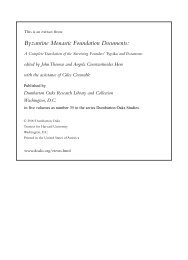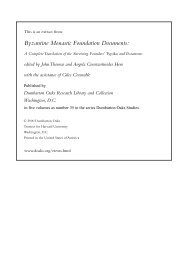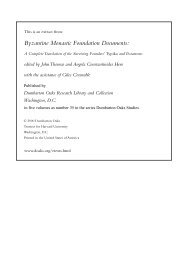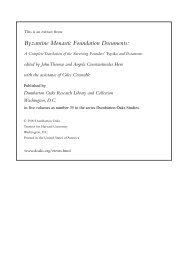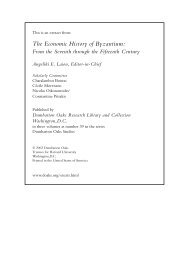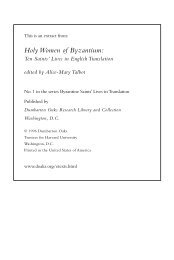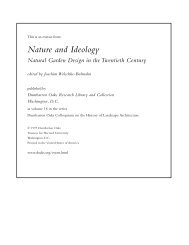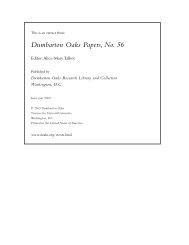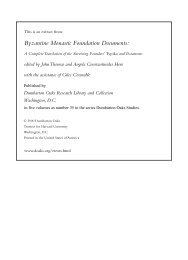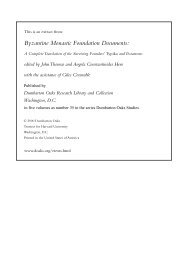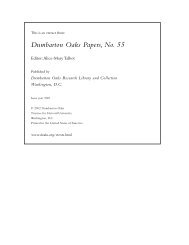Changing Economic Patterns in Latin Romania - Dumbarton Oaks
Changing Economic Patterns in Latin Romania - Dumbarton Oaks
Changing Economic Patterns in Latin Romania - Dumbarton Oaks
Create successful ePaper yourself
Turn your PDF publications into a flip-book with our unique Google optimized e-Paper software.
David Jacoby [ 219 ]<br />
In addition to sale credit, there were also loans and leases based on other types of<br />
contract, which stimulated market and export-oriented <strong>in</strong>vestments of money and labor<br />
<strong>in</strong> land cultivation and the rais<strong>in</strong>g of animals. 130 In Crete the extension of cash crops is<br />
illustrated by contracts stipulat<strong>in</strong>g the expansion of v<strong>in</strong>eyards, especially the plant<strong>in</strong>g of<br />
high-quality Malvasia and Athiri v<strong>in</strong>estocks from the fourteenth century on, <strong>in</strong> response<br />
to a grow<strong>in</strong>g external demand for high-grade Cretan w<strong>in</strong>es. W<strong>in</strong>e became a major item<br />
<strong>in</strong> Cretan exports. 131 Irrigation was already practiced <strong>in</strong> the Byzant<strong>in</strong>e period. It is attested<br />
<strong>in</strong> 1118 for cotton and vegetable cultivation <strong>in</strong> Crete and by a letter of Pope<br />
Innocent III written <strong>in</strong> 1209, thus shortly after the conquest, referr<strong>in</strong>g to gardens and<br />
orchards <strong>in</strong> the bishoprics of Athens and Negroponte. 132 Cistern and well water was<br />
occasionally used for small pieces of land, the latter case attested by a Cretan contract of<br />
1280, 133 yet irrigation was mostly based on the diversion of streams. Irrigation appears<br />
to have been substantially extended after the Lat<strong>in</strong> conquest. It was promoted from<br />
around the turn of the thirteenth century on the ma<strong>in</strong>land, <strong>in</strong> Crete and <strong>in</strong> some Aegean<br />
islands, especially by great landholders and <strong>in</strong>vestors, who more easily than peasants<br />
could muster the large resources needed for the construction and ma<strong>in</strong>tenance of expensive<br />
water<strong>in</strong>g systems. 134 Cotton grow<strong>in</strong>g expanded <strong>in</strong> Crete, and by 1307 the island was<br />
export<strong>in</strong>g its fiber to Venice. By the second half of the fourteenth century, cotton was<br />
also be<strong>in</strong>g grown <strong>in</strong> the countryside of Coron and Modon, as well as <strong>in</strong> Negroponte,<br />
Santor<strong>in</strong>i, and Corfu, obviously <strong>in</strong> response to the <strong>in</strong>creas<strong>in</strong>g demand of the Venetian<br />
cotton <strong>in</strong>dustry. In Frankish Morea, cotton was cultivated <strong>in</strong> the area south of Cor<strong>in</strong>th<br />
and presumably also <strong>in</strong> other areas, s<strong>in</strong>ce it was partly exported from Chiarenza by Ragusan<br />
and Anconitan ships. 135 Irrigation may have occasionally been used for luxury crops<br />
fetch<strong>in</strong>g a high price on the market, such as cherries, marasca or sour cherries, pomegranates,<br />
peaches, and pears. 136 It was <strong>in</strong>dispensable for the grow<strong>in</strong>g of citrus, known <strong>in</strong><br />
130 See above, p. 200.<br />
131 See Topp<strong>in</strong>g, “Viticulture,” 509–20; Gall<strong>in</strong>a, Società, 41–44, 57, 133. See also above, note 23. On external<br />
demand and dest<strong>in</strong>ations, see Jacoby, “Creta,” 80, 85–86, 88, 90–94, 96, 100–102.<br />
132 See Harvey, <strong>Economic</strong> Expansion, 127–33; Gall<strong>in</strong>a, Società, 19–20; Innocent III, Epist., XI.256, PL<br />
215:1560: “flum<strong>in</strong>a unde rigantur horti.”<br />
133 Marcello, no. 251.<br />
134 See Jacoby, “Migration,” 124–25; Gall<strong>in</strong>a, Società, 19–21, 53–54; Gaspares, Hgh, 105–10. In 1352the authorities<br />
<strong>in</strong> Crete <strong>in</strong>tervened <strong>in</strong> a dispute between Venetian landholders over the use of water for irrigation: see<br />
Thiriet, Romanie, 310–11. The construction of an adequate irrigation system was among the heavy <strong>in</strong>vestments<br />
envisaged by Marco de Zanono, who <strong>in</strong> 1428 had obta<strong>in</strong>ed a monopoly for the grow<strong>in</strong>g of sugar cane <strong>in</strong><br />
Crete: see D. Jacoby, “La production du sucre en Crète vénitienne: L’échec d’une entreprise économique,” <strong>in</strong><br />
RODWNIAÚ Timh` stòn M. I. Manoúsaka, ed. C. Maltezou, T. Detorakes, and C. Charalampakes (Rethymno,<br />
1994), 1:172, 175–77, repr. <strong>in</strong> Jacoby, Trade, no. xi.<br />
135 For Venetian territories, see Jacoby, “Creta,” 79; above, note 22, on cotton and flax grown under irrigation<br />
at Lombaro before 1307; Thiriet, Romanie, 321–22; C. N. Sathas, Documents <strong>in</strong>édits relatifs à l’histoire de la<br />
Grèce au Moyen Age (Athens-Paris, 1880–90), 2:119, no. 336; 126, no. 347; 154, no. 385 (respectively <strong>in</strong> 1404,<br />
1405, 1406). For the Morea, see bambaso <strong>in</strong> Longnon and Topp<strong>in</strong>g, Documents, 176–78, 188–92, and M. F. Mazzaoui,<br />
The Italian Cotton Industry <strong>in</strong> the Later Middle Ages, 1100–1600 (Cambridge, 1981), 43.<br />
136 See Gall<strong>in</strong>a, Società, 43–44; Jacoby, “Migration,” 124–25. Accord<strong>in</strong>g to a Cretan contract of 1352, the lessees<br />
of a fruit garden undertook to plant at least ten fruit trees each year, citrus <strong>in</strong>cluded, the species be<strong>in</strong>g determ<strong>in</strong>ed<br />
by the lessor: A. Lombardo, ed., Zaccaria de Fredo, notaio <strong>in</strong> Candia (1352–1357), Fonti per la storia di<br />
Venezia, Sez. III, Archivi notarili (Venice, 1968), no. 82.




